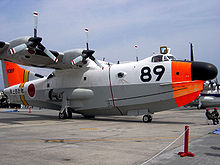Shin Meiwa PS-1
| Shin Meiwa PS-1 | |
|---|---|

|
|
| Type: | Flying boat |
| Design country: | |
| Manufacturer: |
Shin Meiwa |
| First flight: |
5th October 1967 |
| Commissioning: |
1969 |
| Production time: |
1971-1978 |
| Number of pieces: |
21st |
The Shin Meiwa PS-1 and US-1 are Japanese submarine hunters and sea rescue aircraft with STOL properties from the Japanese company Shin Meiwa . The PS-1 was a pure flying boat and the US-1 was an amphibious aircraft .
history
In the early 1960s, Shin Meiwa demonstrated the ability to design aircraft through the prototype of a flying boat (the UF-XS ) with extended STOL features, based on the Grumman Albatros but with a new engine and a newly designed hull. To this end, the company built on the experience of the Kawanishi aircraft works from World War II . After the end of the test series in 1964, the Shin Meiwa received an order from the Japanese Ministry of Defense in January 1966 to develop a flying boat for sea surveillance and submarine hunting. The contract provided for the production of two prototypes called PS-X (in-house as SS-2). The first prototype had its maiden flight on October 5, 1967, the second on June 14, 1968. From 1969, after the JMSDF ordered two pre-series aircraft, PS-1 production began.
From 1971 to 1978 the Japanese Air Force ordered 21 machines and used them until 1989, after which they were replaced by the Lockheed P-3 Orion . The aircraft were extremely costly and politically highly controversial due to the small number of units.
Shortly after the PS-1 went into service, the Japanese Air Force requested a sea rescue aircraft. This is how the US-1 was created as an amphibious aircraft that could also be quickly converted into a troop transport. The first flight took place on October 16, 1974 from the water and on December 3, 1974 from land. 19 machines were ordered and delivered between March 1975 and 2004. From the seventh machine onwards, more powerful engines, a new Litton APN 80N radar and better communication system were installed and the US-1A was created . The first seven machines were also upgraded to this standard. The first rescue flight took place in 1976 to help a Greek freighter in distress.
Since the US-1A slowly became obsolete in the mid-1990s, Shin Meiwa planned a new version, the ShinMaywa US-2 . Their first flight was on December 18, 2003. The Japanese Air Force planned to buy possibly 14 machines and put them into service from 2007. The US-2 received more powerful engines and many other small improvements. The last US-1A (serial number 9090) was decommissioned in December 2017. In the course of its service life, the US-1A rescued a total of 827 people since 1976.
construction
The all-metal airplane had a number of innovations. The boat-shaped hull, support floats on the wings and a system of splash water deflectors should suppress the splashing of the water during take-off and allow operations at wave heights of up to 3 m. The four General Electric turboprop engines manufactured under license by Ishikawajima-Harima had their intake manifolds above the wings. An additional T58 gas turbine with an output of 1014 kW served to improve the STOL properties as a boundary layer influencing system . Up to four torpedoes or six 127 mm rockets and depth charges in the fuselage could be carried as armament between the engines. In the stern was a device for detecting magnetic anomalies, in the bow a radar and a sonar extendable in the water. The three-point landing gear could be used for taxiing on land, but not for take-off or landing. In the later US-1, a retractable landing gear with double tires on the main landing gear was installed, which could also be used for take-off and landing. The armament and equipment for submarine hunting were removed from this machine, but a larger tank volume and appropriate equipment for sea rescue were accommodated.
Technical specifications
| Parameter | PS-1 | US-1A |
|---|---|---|
| crew | 9 + 20 passengers | 8 + 5 doctors |
| length | 33.46 m | 33.46 m |
| span | 33.15 m | 33.15 m |
| Wing area | 135.8 m² | 136 m² |
| height | 9.80 m | 9.82 m |
| Empty mass | 25.5 t | |
| Flight mass | 35.0 t | |
| Max. Takeoff mass | 43.0 t | 45.0 t |
| Top speed | 550 km / h | 522 km / h |
| Marching speed | 425 km / h | 425 km / h |
| Service ceiling | 7000 m | 7200 m |
| Range | 2170 km | 3820 km |
| Engines | 4 × Turbo-Prop General Electric T64-IHI-10 , 2282 kW each | 4 × Turbo-Prop General Electric T64-IHI-10J, each 2605 kW |

